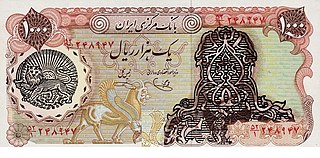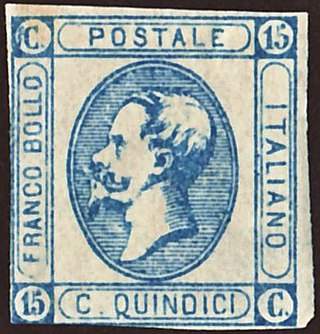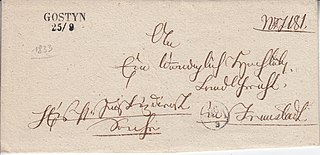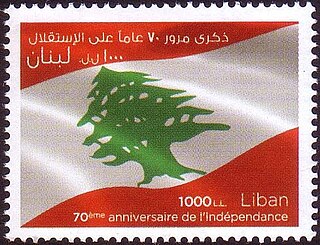
An overprint is an additional layer of text or graphics added to the face of a postage or revenue stamp, postal stationery, banknote or ticket after it has been printed. Post offices most often use overprints for internal administrative purposes such as accounting but they are also employed in public mail. Well-recognized varieties include commemorative overprints which are produced for their public appeal and command significant interest in the field of philately.
This is a partial timeline of significant events in postal history, including dates and events relating to postage stamps.

This is an introduction to the postal and philatelic history of Italy.
Each "article" in this category is a collection of entries about several stamp issuers, presented in alphabetical order. The entries themselves are formulated on the micro model and so provide summary information about all known issuers.
Each "article" in this category is a collection of entries about several stamp issuers, presented in alphabetical order. The entries are formulated on the micro model and so provide summary information about all known issuers.

The United Nations Postal Administration (UNPA) is the postal agency of the United Nations. It issues postage stamps and postal stationery, denominated in United States dollars for the office in New York, in Swiss francs for the office in Geneva and in euros for the office in Vienna. As such, UNPA is the only postal authority that issues stamps in three different currencies.

The postal history of Morocco is complex due to the country's political development in the 20th century. Mail was sent via post offices operated by the Sherifian post created by the Sultan, and by the European powers. After Morocco was partitioned into protectorates of France and of Spain in 1912, both European administrations established postal services in their respective zones.
The postage stamps and postal history of Palestine emerges from its geographic location as a crossroads amidst the empires of the ancient Near East, the Levant and the Middle East. Postal services in the region were first established in the Bronze Age, during the rule of Sargon of Akkad, and successive empires have established and operated a number of different postal systems over the millennia.
The Austro-German Postal Union was a union of the postal systems of the Austrian Empire and the pre-Empire German states. The union was established on 1 July 1850. The administrative prerequisites were already provided by the German Zollverein established in 1834. On 18 October 1847 the representatives convened to the German Postal Conference in Dresden on a suggestion of Prussia and Austria. Not until 6 April 1850, Prussia and Austria, slowed by political circumstances, closed a contract establishing a German–Austrian Postal Association in Berlin.

This article is about the postage stamps and postal history of Hamburg from the medieval messengers until the entry of the Hamburg Postal Administration into the Northern German Postal District in 1868.

Österreichische Post is the company responsible for postal service in Austria. This company was established in 1999 after its split-off from the mail corporate division of the former state-owned PTT agency Post- und Telegraphenverwaltung. It is listed on the Vienna Stock Exchange.

Poczta Polska, the Polish postal service, was founded in 1558 and postal markings were first introduced in 1764. The three partitions of Poland in 1772, 1793 and 1795 saw the independent nation of Poland disappear. The postal services in the areas occupied by Germany and Austria were absorbed into those countries' postal services. In 1772 the area occupied by Austria was created into the Kingdom of Galicia, a part of the Austrian Empire. This lasted till 1918. The Duchy of Warsaw was created briefly, between 1807 and 1813, by Napoleon I of France, from Polish lands ceded by the Kingdom of Prussia under the terms of the Treaties of Tilsit. In 1815, following Napoleons' defeat in 1813, the Congress of Vienna, created Congress Poland out of the Duchy of Warsaw and also established the Free City of Kraków. Congress Poland was placed under the control of Russia and the postal service was given autonomy in 1815. In 1851 the postal service was put under the control of the Russian post office department regional office in St Petersburg. In 1855 control was restored for a while to the Congress Kingdom but following the uprising in 1863 again came under Russian control from 1866 and continued until World War I. In November 1918 the Second Polish Republic was created.

This is a survey of the postage stamps and postal history of Lebanon, formerly known as Liban.

This is a survey of the postage stamps and postal history of Liechtenstein.

The U.S. Parcel Post stamps of 1912–13 were the first such stamps issued by the U.S. Post Office Department and consisted of twelve denominations to pay the postage on parcels weighing 16 ounces and more, with each denomination printed in the same color of "carmine-rose". Their border design was similar while each denomination of stamp bore its own distinctive image in the center (vignette). Unlike regular postage items, whose rates were determined by weight in ounces, Parcel Post rates were determined and measured by increments in pounds. The new stamps were soon widely used by industry, farmers and others who lived in rural areas. Partly owing to some confusion involving their usage, their exclusive use as Parcel Post stamps proved short lived, as regular postage stamps were soon allowed to be used to pay parcel postage rates.

British post offices in Crete provided the postal service in the territory of the island of Crete. Stamps inscribed in Greek were used in the British sphere of administration (Heraklion) during the Great Powers occupation of the island in 1898–1899.
This is a survey of the postage stamps and postal history of Mount Athos.










